Neutrinos not so fast
Scientists say the particles may not outrace light after all
In September, European scientists reported on tiny particles called neutrinos that traveled faster than the speed of light. Physicists, the scientists who study energy in all its forms, have long believed that nothing outpaces light in a race through empty space. Understandably, September’s announcement seemed too amazing to be true.
Skeptical scientists quickly started picking the experiment apart. In recent papers, they claim superluminal neutrinos seem too fast to be true because they probably are too fast to be true. (“Superluminal” means “faster than light.”) According to these scientists, the universal speed limit likely still stands at 670 million miles per hour, the speed of light.

As they traveled, the superswift particles should have been losing energy in the form of radiation, say physicists from Boston University. OPERA’s measurements didn’t show the expected energy loss in the neutrino beam. As a result, the experiment’s results seem off, say the Boston duo.
“I would be ecstatic to see some kind of new physics coming from this experiment,” Andrew Cohen, one of the Boston University physicists, told Science News. But the radiation evidence wasn’t there. “It’s just hard to accommodate” the conclusion that the particles outraced light, he says. Cohen worked with his colleague Sheldon Glashow, who won a Nobel Prize in 1979.
A separate team of scientists in Italy conducted a follow-up neutrino experiment to look for the missing radiation, but it didn’t show. Cohen and Glashow’s study doesn’t completely disprove the results, but it does suggest something went awry in the original experiment.
“We’re pretty much convinced that the experiment is wrong,” Glashow told Science News. “But I don’t think anyone has identified the error, if there is an error, as of yet.”
Scientists do have some ideas. A French physicist in Grenoble wonders if some of the neutrinos in the beam started their trip earlier than the scientists think. And a physicist in England, Carlo Contaldi, suggests that the clocks used to time the neutrinos may have been out of sync with each other. Contaldi points out that gravity tugs harder on the Swiss clock than on the one in Italy, and as a result they may have been ticking at different times.
Contaldi told Science News that he’ll be able to check his idea once the OPERA team starts talking more about their work.
“Until further details come out as to how they did the various bits of their experiment,” he said, “it’s not clear how to proceed.”
The case of the superluminal neutrinos shows the progress of science, from an astonishing find to the grueling work of verifying the results. Even if the neutrinos do obey the speed limit, the OPERA results will have given scientists valuable knowledge about the behavior of supersmall, superfast neutrinos.







